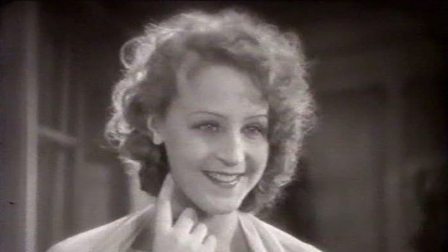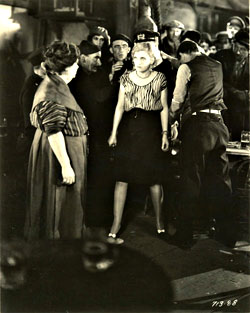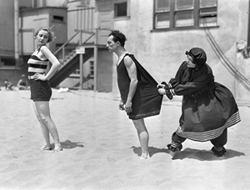
This year Wellman's Wings and Lubitsch's Das Weib des Pharao (The Loves of Pharaoh) will be shown digitally. In the case of the latter, I'm not aware of the recent "restoration" ever being put back onto film, and extant prints, those that were scanned and patched together to make this not-quite-complete version, individually are quite incomplete, in poor physical condition, and do not circulate. Used to be film restorers would physically repair elements such as these so they could be reprinted and spliced together. Now, often as not, we're just left with data. Wings, on the other hand, certainly exists on film, in both pre-digital and post-digital versions, and I for one could easily forgo the digitally re-imagined color effects in favor of an all-photochemical monochrome print.
(Also being shown digitally, in front of The Cameraman, is Méliès's Le voyage dans la lune (A Trip to the Moon). Why not wait a month and see it on film at the Castro, when it plays with 2001... which will be digital--you can't win!)
In the It's being shown on film but was restored digitally so why bother file we have Pabst's Die Büchse der Pandora (Pandora's Box), one I'd like to revisit properly since my viewing 12 years ago didn't stand up to the film's reputation, and Herbert Brenon's The Spanish Dancer, which may be unavailable any other way. More on this last one may be read here.
Now let's take a closer look at the remaining prints, those that can be relied on to provide a true filmic experience.
Little Toys
Weeell, I never have had any luck contacting the China Film Archive. But I'm guessing this is a straight photochemical preservation.
Mantrap and The Canadian
Both of these 1926 Canada-set (though Mantrap was shot in California) films were preserved from nitrate prints in the '80's. The Mantrap print was struck last year, and reportedly looks great (and unlike its DVD counterpart, features no digital touch-up).
Die wunderbare Lüge der Nina Petrowna (The Wonderful Lie of Nina Petrovna)
 |
Irrepressible Felix the Cat!
Felix the Cat in Blunderland and Felix the Cat Weathers the Weather are both UCLA preservations, blown up to 35mm from 16mm diacetate (an early safety filmstock) at the Stanford Theatre Film Laboratory, with, in the case of Weathers, a little help from the film-repair experts at Film Technology Company, Inc. Felix Loses Out, Jungle Bungles, and Eskimotive were preserved at Library of Congress from 35mm nitrate prints in 2011, 2005, and 2005, respectively. And Eastman House reports that Felix the Cat Trips Through Toyland (A replacement for Felix Gets Revenge?) and Felix the Cat Flirts with Fate both came from finegrains (a preservation element) made from nitrate negatives in 1978, from which, in 2004, dupe negs and prints were struck.
South
Like The Great White Silence (shown at last year's SFSFF), South is the photographic artifact of an ill-fated Antarctic expedition and features lots of penguins. Both are BFI restorations, but as South's was completed in the '90's it's strictly photochemical, and we'll be seeing a print on black and white stock tinted and toned via traditional dye bath, a process the BFI deems cost-prohibitive at present.
Шинель (The Overcoat)
While this print comes from BFI as well, it's simply a distribution print they acquired from Moscow. You'll recall from last year's edition of TSW that the Muscovites are notorious for cropping the silent frame in their printers. Hopefully this print hasn't suffered that misfortune.
The Mark of Zorro
This is a safety print struck from MOMA's nitrate negative in 1963 and held in Eastman House's collection. I'm told the resulting image is beautiful, though there's always the possibility it will show off several decades' worth of handling.
The Docks of New York
 |
Erotikon
An edited version of this film was shown in Sweden a few years after the original release, and from a print of this cut, further shortened by a nitrate fire, a duplicate negative was finally made on safety stock in 1969. In 2005 the print we will see was struck on color stock, tinting and toning having been added by the Desmet method. Altogether about 12 minutes are missing.
Stella Dallas
This print, a blow-up from 16mm, was purchased from Warner Bros. for a 2006 Ronald Colman retrospective at the Stanford Theatre (where it played again earlier this year), and then deposited at UCLA.
The Cameraman
Buster Keaton's first MGM picture, and the last great picture of his heyday, was for decades only viewable in a not-so-hot blowup from a small-gauge print found in France. Apparently a finegrain had been lent to compilation-"documentarian" Robert Youngson, who physically removed clips from it for use in his The Big Parade of Comedy and didn't return the rest. This finegrain, minus reel one, was found by David Shepard amongst a garage-full of film left after Youngson's death. After the clips from Big Parade were repatriated, it remained to find the first reel in decent condition. Fortunately, a 16mm reduction from the camera negative that had been made for restoration pioneer Karl Malkames had been passed down to his grandson, film historian Bruce Lawton, and was lent for this project.
 |
Thanks to Jared Case, Bryony Dixon, Steven Hill, Mike Mashon, Anita Monga, Cyndi Mortensen, Ed Stratmann, Jon Wengström, and Anke Wilkening for answering all my inquiries.
 |
I still dispute his claims of irreparability. A friend who used to work for YCM Labs routinely had to contend with film in such straits, and spent countless hours laboriously replacing missing perforations on film in various states of shrinkage. It's tedious and time-consuming, but it can be done.